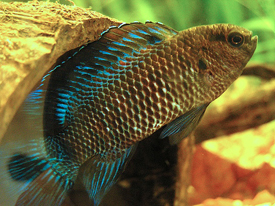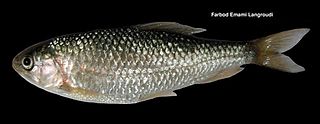
The Indus is a transboundary river of Asia and a trans-Himalayan river of South and Central Asia. The 3,180 km (1,980 mi) river rises in Western Tibet, flows northwest through the Ladakh and Gilgit-Baltistan regions of Kashmir, bends sharply to the left after the Nanga Parbat massif, and flows south-by-southwest through Pakistan, before it empties into the Arabian Sea near the port city of Karachi.
Watson's climbing rat is a species of rodent in the family Cricetidae. It is found in Costa Rica and Panama.

Badis badis, also known as the blue perch or blue badis, is a small species of Asian freshwater fish in the family Badidae of the order Anabantiformes. It is found in ponds, rivers, ditches and swamps in northern India, eastern Pakistan, Bangladesh, Bhutan and Nepal, including the Ganges, Brahmaputra, Mahanadi and Indus basins. It is sometimes kept as an aquarium fish. It is a small, predatory fish that feeds on tiny invertebrates. Maximum total length is around 8 cm (3 in). It is sexually dimorphic, with males growing larger and being more colorful, especially when excited, compared to females. Adult males have blue fins and may display dark vertical bands on the flanks, while the smaller females display little color. Several similar relatives, now recognized as separate Badis species, have historically been confused with Badis badis. Historically the two genera that now make up the Badidae, Badis and Dario, were placed in the family Nandidae; this is no longer the case.

The wildlife of Pakistan comprises a diverse flora and fauna in a wide range of habitats from sea level to high elevation areas in the mountains, including 177 mammal and 660 bird species. This diverse composition of the country's fauna is associated with its location in the transitional zone between two major zoogeographical regions, the Palearctic, and the Oriental.

Pakistan's native fauna reflect its varied climatic zones.

Thomas's fruit-eating bat, sometimes also popularly called Watson's fruit-eating bat, is a species of bat in the family Phyllostomidae. It is found from southern Mexico, through Central America to Colombia. Its South American range is to the west of the Andes. The species name is in honor of H. J. Watson, a plantation owner in western Panama who used to send specimens to the British Natural History Museum, where Oldfield Thomas would often describe them.

The eastern billabongfly is a damselfly in the family Coenagrionidae. It is also known as the eastern dart. Eastern billabongflies are small damselflies about 25mm (1 inch) in length. They are found near slow running water or still water, such as lakes, ponds and ditches. Male and female eastern billabongflies mate in a wheel position.

The black-line rasbora or slender rasbora, is a species of ray-finned fish in the genus cyprinid family. It is found in rivers of South and Southeast Asia, ranging from Sri Lanka and the Indus basin to northern Malay Peninsular and the Mekong.

Cyprinion is a genus of ray-finned fish in the family Cyprinidae.

Cyprinion kais, the Kais kingfish or smallmouth lotak, is a species of ray-finned fish in the genus Cyprinion. It is found in the drainage basins of the rivers Tigris and Euphrates, and was also found in the Queiq system but it appears to have been extirpated from that basin following the drying up of that river. Its range covers Turkey, Syria, Iraq and Iran. Its preferred habitat is flowing water in larger warm streams and rivers from where it migrates to canals and probably to other artificial water bodies to forage.

Cyprinion macrostomum, also known as the kangal fish, is a ray-finned cyprinid It is native to Iran, Syria and Turkey.
Cyprinion milesi is a species of ray-finned fish in the genus Cyprinion from Pakistan, Afghanistan and Iran.

Cyprinion semiplotum, the Assamese kingfish, is a species of cyprinid fish native to southern Asia where it occurs in fresh waters of India, Nepal, Bhutan and Myanmar. This species can reach a length of 60 centimetres (24 in) TL. It is of minor importance to local commercial fisheries.
Cyprinion mhalensis is a species of ray-finned fish in the genus Cyprinion. It is endemic to the eastern part of the Sarawat Mountains in Saudi Arabia where it occurs in the upper reaches of wadis. It has been recorded from shallow, permanent and slow running water, as well as intermittent streams.
Cyprinion acinaces is a species of ray-finned fish in the genus Cyprinion. This species has two subspecies Cyprinion acinaces acinaces and Cyprinion acinaces hijazi, though the validity of the latter is in doubt. If C. a. hijazi is invalid, then C. acinaces would be monotypic. The species occurs from western, central and northern Saudi Arabia to Yemen.
Cyprinion microphthalmum is a species of ray-finned fish in the genus Cyprinion. This species may be a synonym of Cyprinion watsoni. If valid it is found in Iran, Pakistan, Afghanistan and the Arabian peninsula.

Osteobrama cotio is a species of ray-finned fish in the genus Osteobrama. This species had three subspecies named O. cotio cotio, O. cotio cunma and O. cotio peninsularis but these are now considered separate species. This species is found in the drainage basins of the Ganges-Brahmaputra including Jiri River in Manipur, Barak River in Silchar, in Brahmaputra River, Uzan Bazaar in Assam, and in Bihar, Madhya Pradesh, Uttar Pradesh, and Punjab in India, and in Bangladesh. The presence of O. cotio in southern India and from the Indus basin of India and Pakistan needs to be confirmed. This species is threatened by extensive loss of habitat caused by pollution and deforestation.

The Indus river dolphin, also known as the bhulan in Urdu and Sindhi, is a species of toothed whale in the family Platanistidae. It is endemic to the Indus River basin of Pakistan, with a small remnant population in the Beas river in India. This dolphin was the first discovered side-swimming cetacean. It is patchily distributed in five small, sub-populations that are separated by irrigation barrages.

Spinaeschna watsoni is a species of dragonfly in the family Telephlebiidae, known as the tropical cascade darner. It is a medium to large, dark brown dragonfly with greenish-yellow markings. It is endemic to north-eastern Australia, where it inhabits streams and rivers.













